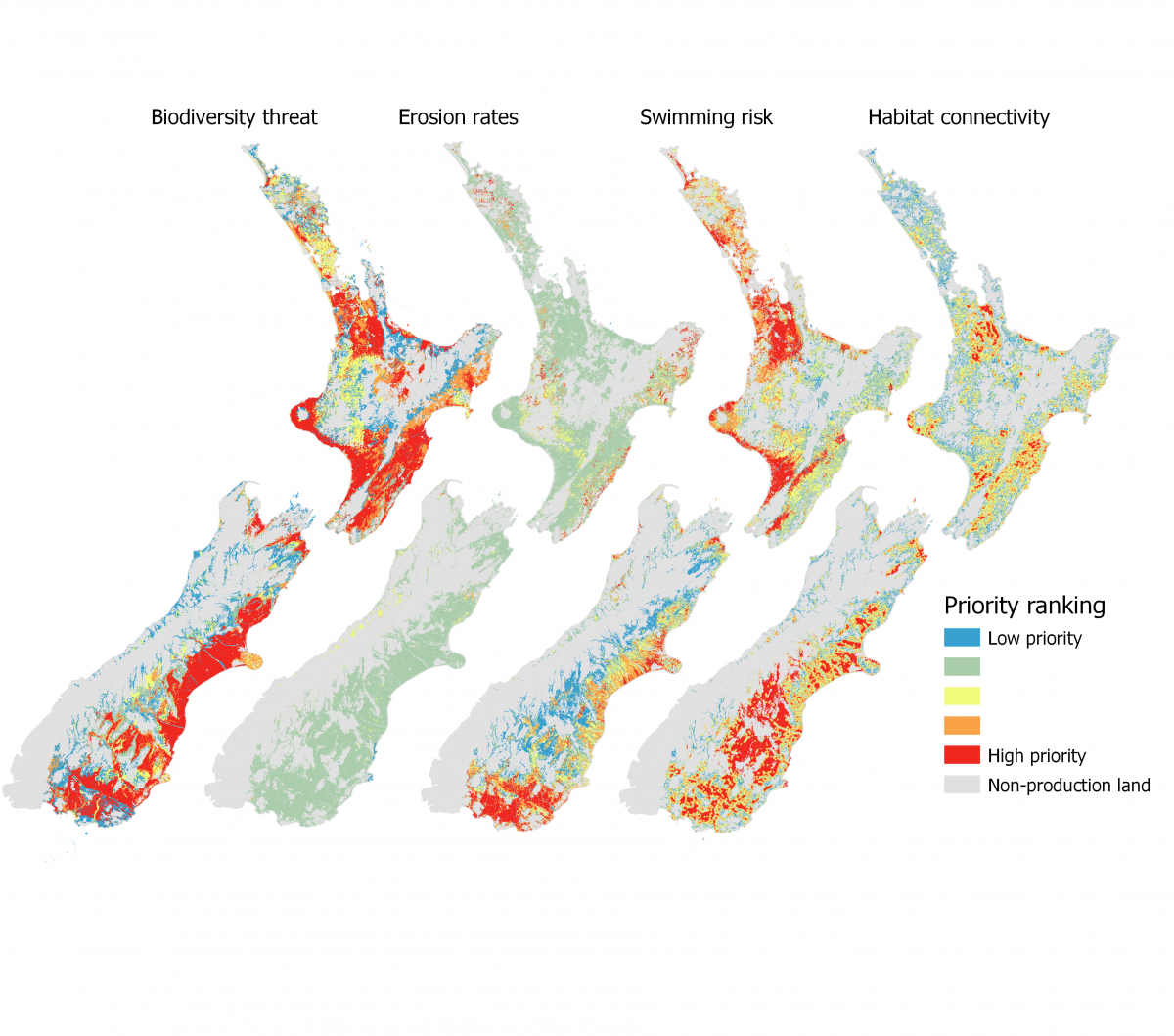Published online: January 2020
Synthesis by: Dr Bradley Case, Auckland University of Technology (bradley.case @ aut.ac.nz)
The One Billion Trees (1BT) programme was launched in early 2018 by the newly-established Te Uru Rākau/Forestry New Zealand with the goal of planting one billion trees by 2028. This initiative aims to use reforestation to improve land productivity, provide alternative incomes (e.g. tree and carbon farming, honey production), and improve water quality, biodiversity, habitat provisioning and carbon sequestration. In parallel, the government has the goal of making New Zealand Carbon neutral by 2050 and will be aiming to address the current biodiversity crisis via a revamped Biodiversity Strategy in 2020.
The 1BT project comes at a time when New Zealand’s environmental quality is at its poorest ever, necessitating a change to business-as-usual. Privately-owned agricultural lands contain marginally-productive areas, such as gullies and erosion-prone hillslopes, that would provide available land for reforestation activities, and for restoring unique components of biodiversity It is clear that achieving the 1BT’s carbon and biodiversity goals would benefit from a re-visioning of how agroecosystems are managed and targeted revegetation interventions.
A primary question is: how can 1BT dovetail with ecological and social aspirations to achieve a shift in agroecosystem management towards country-wide integration of biodiversity into agricultural landscapes? The American ecologist Aldo Leopold proposed the idea of a ‘land ethic’ – an ethical framework by which humans might live both profitably and sustainably with the land. A land ethic is deeply rooted in the Māori world view in the concept of kaitiakitanga; most recently Western science has reincarnated the land ethic idea with the term ‘multi-functionality’. However, despite gains in our understanding of how agroecosystems function, there has been little progress towards mitigating New Zealand’s urgent environmental situation. This lack of progress has partially resulted from ongoing tensions between two contrasting viewpoints around the management of private agricultural land: one that advocates for a more regulatory approach, and the other that aims to inspire landowners to act voluntarily through a combination of incentivisation, and the influence of ‘peer-pressure’ within the farming community. Through our Farming & Nature Conservation project in New Zealand’s Biological Heritage National Science Challenge, we have observed a healthy land ethic in the farming community. The challenge, then, is to support this commitment by famers to manage their land sustainably, and to determine how to best use large-scale programmes like 1BT to formulate an agroecological native re-vegetation framework that incorporates both regulatory and voluntary components.
From a social-ecological point of view, the potential for country-wide native re-vegetation afforded by 1BT provides an impetus to co-design agroecosystems for multiple beneficial outcomes. We suggest that this is an opportunity to repurpose targeted parts of production landscapes for 1BT, based on genuine partnerships between different groups and grounded in ecological science and kaitiakitanga. This integration will lead to multiple wins for communities, the environment, farmers’ bottom lines, and scientific understanding of agroecosystems. The first step will be to identify priority areas using multiple criteria (e.g., Fig. 1), and then refine this template at finer spatial scales (e.g. farm by farm basis) based on input from landowners, mana whenua, scientists, and councils. For example, the refinement process could be based around priorities for a given watershed and should include assessments of how to achieve synergies among environmental, cultural, social, and economic objectives. From an ecological perspective, a mix of treatments will be necessary to restore native forest cover, including not just tree planting, but also effectively managing natural successions by tackling issues such as dispersal limitation and the impacts of excessive herbivory and invasive animals and plants.

Figure 1. GIS-based analyses of spatial datasets can be used to prioritise key ecological and environmental factors on privately-owned land to facilitate targeted re-vegetation activities across New Zealand. Here, four datasets have been ranked into five priority levels from lowest priority (blue) to highest priority (red), providing a way to visualise, discuss and target potential sites for re-vegetation activities.
Project collaborators: Hannah Buckley (AUT), David Norton (U Canterbury), David Hall (AUT), Feby Suryaningrum (AUT), Adam Forbes (Forbes Consulting)
References
Case, B.S., Pannell, J.L., Stanley, M.C., Norton, D.A., Brugman, A., Funaki, M., Mathieu, C., Songling, C., Suryaningrum, F. and Buckley, H.L. (2019). Non-production vegetation has a positive effect on ecological processes in agroecosystems. bioRxiv, 624635.
Hall, D. 2016. Our Forest Future. Pure Advantage. Available from https://pureadvantage.org/news/2016/04/22/our-forest-future/#
Landis, D.A. (2017). Designing agricultural landscapes for biodiversity-based ecosystem services. Basic and Applied Ecology, 18, 1–12.
Lawton, J.H., Brotherton, P.N.M., Brown, V.K., Elphick, C., Fitter, A.H., Forshaw, J., Haddow, R.W., Hilborne, S., Leafe, R.N., Mace, G.M., Southgate, M.P., Sutherland, W.J., Tew, T.E., Varley, J., & Wynne, G.R. (2010) Making Space for Nature: a review of England’s wildlife sites and ecological network. Report to Defra. https://webarchive.nationalarchives.gov.uk/20130402170324/http:/archive.defra.gov.uk/environment/biodiversity/documents/201009space-for-nature.pdf
Manning, P., Plas, F., Soliveres, S., Allan, E., Maestre, F.T., Mace, G., Whittingham, M.J. and Fischer, M. (2018). Redefining ecosystem multifunctionality. Nature Ecology & Evolution, 2, 427–436.
Ministry for the Environment & Stats NZ. (2019). New Zealand’s Environmental Reporting Series: Environment Aotearoa 2019. Available from www.mfe.govt.nz and www.stats.govt.nz.
New Zealand Government (2019). Climate Change Response (Zero Carbon) Amendment Bill. Available from www.legislation.govt.nz.
Norton, D. and Reid, N, 2013. Nature and farming: Sustaining native biodiversity in agricultural landscapes. CSIRO Publishing.
Te Uru Rakau Forestry New Zealand. (2018). The One Billion Trees Programme: Our future, our billion trees. Available from www.mpi.govt.nz
